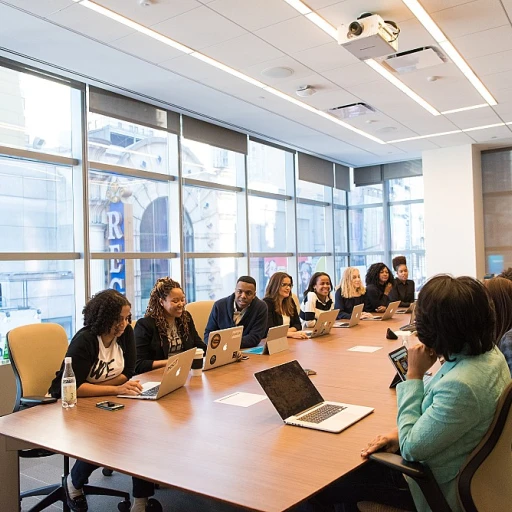
Understanding the Impact of Meetings on Work-Life Balance
The Influence of Meetings on Work-Life Harmony
Meetings are an integral part of any professional environment, yet they can significantly impact the delicate balance between work and personal life. Understanding this impact is crucial for fostering a healthy work environment. Meetings, when not managed effectively, can consume valuable time, leaving team members feeling overwhelmed and stressed. This can lead to a decrease in productivity and overall job satisfaction.
Team meetings should be structured to support team building and collaboration, rather than becoming a source of frustration. It's essential to recognize that the topics discussed and the way meetings are conducted can either contribute to or detract from a team's well-being. By focusing on purposeful meeting agendas, teams can ensure that each meeting serves a clear objective, helping to keep team members engaged and motivated.
Moreover, incorporating flexibility in meeting schedules can provide team members with the opportunity to manage their time more effectively, reducing stress and enhancing their ability to balance work and personal commitments. This flexibility, combined with promoting inclusivity in meeting topics, ensures that all team members feel valued and heard, fostering a sense of belonging and collaboration.
To further enhance meeting efficiency, utilizing technology can streamline communication and reduce the time spent in meetings. This approach not only helps in achieving goals more efficiently but also provides development opportunities for team members to engage in professional development and problem-solving activities.
Regular evaluation of meeting effectiveness is another critical step in maintaining a healthy work-life balance. By gathering feedback from the team, organizations can identify areas for improvement and make necessary adjustments to ensure meetings are productive and beneficial for all involved. For more insights on crafting effective engagement questions for better work-life balance, you can read this article.
Crafting Purposeful Meeting Agendas
Designing Meeting Agendas That Resonate
The creation of a purposeful meeting agenda is a crucial step in ensuring that meetings contribute positively to a work-life balance. A well-crafted agenda not only sets clear goals for what the meeting aims to achieve but also provides a roadmap that helps keep team members engaged and focused. By defining specific topics beforehand, teams can utilize their time more efficiently and concentrate on areas that matter most, allowing for more innovative problem-solving and professional development. To start, consider integrating team input when drafting an agenda. Gathering feedback from team members can help identify the subjects and areas of improvement that truly resonate with your team. This inclusive approach can make meetings more dynamic and foster a shared sense of responsibility. Additionally, this step encourages collaboration, elevating a mere agenda into a valuable team-building tool. Further, allocate specific time slots for each topic on the agenda. Doing so prevents meetings from derailing into endless discussions and helps to keep things precise and productive. Establishing a time-limit can also promote more focused conversations, giving team members the opportunity to voice their insights and ensuring that all crucial topics receive attention. It's also important to incorporate check-ins and development opportunities into meeting frameworks. Including moments for team members to discuss their achievements, challenges, or professional growth enables a culture of continuous learning and development. Not only does this help teams align with each other’s progress, but it also provides time to celebrate successes and build a high-performing work environment. Designing agendas that captivate and effectively engage your team is not just about setting out a list of tasks. It’s about crafting a tool that accelerates productivity and strengthens team dynamics. For more information on developing effective internal communication practices, consider checking out this insightful article on enhancing internal communication which offers extensive strategies to refine your team's interaction and cohesiveness.Incorporating Flexibility in Meeting Schedules
Encouraging Flexibility for a Balanced Schedule
Integrating flexibility into meeting schedules significantly contributes to a healthier work-life balance. By accommodating diverse team needs and personal responsibilities, flexible scheduling helps reduce stress and enhances team well-being.
Consider the following strategies to incorporate flexibility into your meetings:
- Time Considerations: Recognize that not all team members operate on the same schedule. Offering varied meeting times allows for better participation and consideration of individual work-life scenarios.
- Agenda Adjustments: Tailor your meeting agenda to address priority topics when most team members are available. This ensures that the meeting is productive without encroaching on personal time.
- Remote Participation: Offer virtual attendance options to those who may have commitments that prevent in-person attendance. This keeps everyone engaged while respecting personal obligations.
- Flexible Check-Ins: Implement shorter, more frequent check-ins instead of lengthy, exhaustive meetings. These can help maintain team alignment and provide opportunities for quick problem-solving.
- Intentional Breaks: Schedule breaks during longer meetings to help maintain focus and reduce fatigue, encouraging better collaboration and decision-making.
Implementing these strategies in your team's routine not only improves meeting efficiency but also contributes to high-performing teams and satisfied team members. For a detailed step guide on crafting the perfect meeting template, visit this article.
Promoting Inclusivity in Meeting Topics
Encouraging Diverse and Inclusive Meeting Subjects
Focusing on inclusivity within team meetings can significantly enhance their overall effectiveness, leading to a well-rounded work-life balance. By promoting diverse meeting topics, teams can explore different perspectives and encourage a supportive work environment. Incorporating inclusivity in meeting subjects not only accommodates various viewpoints but also keeps team members engaged and motivated.
When organizing a meeting agenda, it is crucial to consider the diversity within your team. Create opportunities for team members to suggest topics, prompting valuable discussions on areas for improvement and professional development. This approach ensures that everyone is heard, fostering a sense of belonging and mutual respect among team members.
Inclusivity also involves making sure that meeting topics are relevant to everyone in attendance. By tailoring topics to suit the interests and goals of individual members, teams can engage in more meaningful collaborations. This strategy helps in keeping the meetings on track, ensuring that each team member feels involved and that their contributions are valued.
Moreover, promoting inclusivity in meetings leads to improved team building opportunities. Team members can participate in team-building activities during meetings, which enhances collaboration and can serve as a platform for effective problem-solving. Encouraging a culture of inclusivity in meeting topics not only benefits the work-life balance of team members but also contributes to the creation of a high-performing team.
Finally, creating a safe space for feedback during meetings is essential. It’s important to establish boundaries that allow team members to express their opinions freely, contributing to the team’s continuous improvement. Regular feedback serves as a step guide to identify areas where meetings could be more inclusive and effective.
Utilizing Technology to Enhance Meeting Efficiency
Leveraging Technological Tools for Streamlined Meetings
In today's fast-paced work environment, technology plays a pivotal role in enhancing meeting efficiency. By leveraging the right tools, teams can ensure that each meeting is as productive as possible. Here’s how integrating technology can assist in achieving this goal:- Facilitating Remote Collaboration: Modern technology allows team members to join meetings from anywhere, providing the flexibility required for a healthy work-life balance. Video conferencing platforms ensure that everyone can participate, regardless of their location.
- Efficient Communication: Text and messaging applications that offer real-time communication help team members discuss topics swiftly, allowing meetings to focus on decision-making and strategy rather than information exchange.
- Task and Time Management: Tools that track and allocate minutes effectively help keep meetings on schedule, ensuring that each agenda topic receives adequate attention and that team members remain focused on the goals.
- Record-Keeping and Sharing: Technology enables easy document sharing and access to past meeting records, giving team members the chance to review materials before meetings and providing a source of continuous professional development.
- Feedback Mechanisms: Integrated feedback systems help teams gather input on meeting efficacy, offering opportunities for improvement and fostering a better work environment. By regularly evaluating what works well and what needs adjustment, the team can enhance collaboration and productivity.
Evaluating Meeting Effectiveness Regularly
Regular Check-Ins for Meeting Improvements
Regular evaluations of meeting effectiveness can significantly enhance work-life balance by ensuring that gatherings are not draining resources unnecessarily. By conducting frequent check-ins and soliciting feedback from team members, organizations can identify areas for improvement and address issues efficiently.
Incorporating structured feedback sessions into team meetings can help leaders learn what works well and what does not. By doing this, teams can effectively reassess their meeting agendas and incorporate topics that foster collaboration and solve problems together.
It's essential to involve all team members in this process. By ensuring everyone has a voice, you maintain an inclusive work environment where feedback is valued. This approach not only helps identify opportunities and development areas but also promotes high-performing teams that are aligned with their goals.
Measuring meeting efficiency goes beyond analyzing the minutes or sticking to fixed schedules. It involves checking whether the meeting topics addressed the team's current needs and whether the gathered insights have contributed to professional development and goal achievement.
Regular evaluations are central to creating a safety net where team members feel supported and trusted. This, in turn, aids in building a positive team spirit and achieving a sustainable work-life balance.












